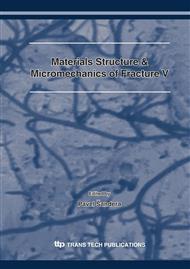p.105
p.109
p.113
p.117
p.123
p.129
p.133
p.137
p.141
The Half-Cycle Slip Activity of Persistent Slip Bands in Polycrystals
Abstract:
The development of the volume fraction of cumulated persistent slip bands (PSBs) in cyclically deformed nickel polycrystals was investigated in dependence on the number of cycles using scanning electron microscopy (SEM) and atomic force microscopy (AFM). It was shown that there is a large scatter of the volume fraction of PSBs from grain to grain. Three different tendencies for the development of the volume fraction with increasing number of cycles were distinguished. It was shown that there is a correlation of the orientation of the primary slip systems with the volume fraction of cumulated PSBs and the activation of PSBs during half-cycle deformation.
Info:
Periodical:
Pages:
123-127
Citation:
Online since:
December 2007
Authors:
Price:
Сopyright:
© 2008 Trans Tech Publications Ltd. All Rights Reserved
Share:
Citation:


